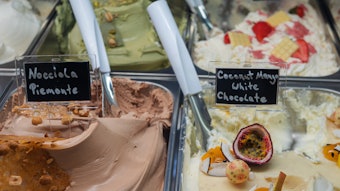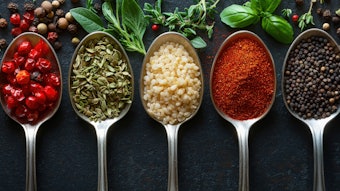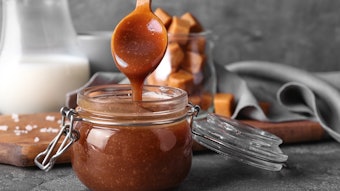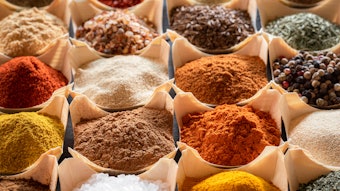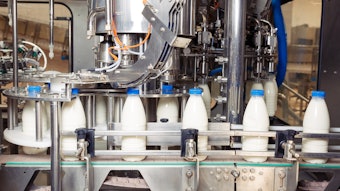
Thanks to recent advances in neuroscience, all 40 taste receptors for the 5 basic tastes in the mouth have been identified. Twenty six of these receptors are dedicated to bitterness detection17, and they are called TAS2Rs. TAS2R are glycoproteins1 with 300 amino acids12, and each bitter taste cell expresses multiple TAS2Rs1.
This article is only available to registered users.
Log In to View the Full Article
Bitterness Neuroscience
Thanks to recent advances in neuroscience, all 40 taste receptors for the 5 basic tastes in the mouth have been identified. Twenty six of these receptors are dedicated to bitterness detection17, and they are called TAS2Rs. TAS2R are glycoproteins1 with 300 amino acids12, and each bitter taste cell expresses multiple TAS2Rs1.
Detection starts at the TAS2R in the mouth. There are two major features about them. First, they are broadly tuned, meaning one receptor can be triggered by many bitter compounds. For example, TAS2R14 is triggered by both Reb A and caffeine, and is the most broadly tuned TAS2R (with 151 ligands listed in BitterDB2). Second, bitter detection operates on a many-on-many mode. This means one bitter compound can trigger multiple receptors. For example, caffeine triggers 5 receptors: TAS2R7, 10, 14, 43, 463.
That was receptors, how about bitter compounds? What we call bitter compounds in foods are called agonists in neuroscience. There are 2,250 bitter compounds found as of 20252; we humans recognize more than 100 of them 2,18. Bitter compounds are mostly hydrophobic and small, with molecular weight at or less than 4004.
Detection in the mouth leads to perception in the brain, so how is bitterness perceived? There are also two major features about perception. First of all, there are major differences in human bitterness perception due to gene mutation (>150 polymorphs in humans)5, age, gender, environmental and cultural factors6. The second feature is individual sensitivity, as 25% of us are very sensitive to bitterness due to TAS2R38 polymorphisms7 and, maybe, papillae density.
Bitterness Blockers
Bitterness blocker literature is confusing, as we describe maskers as blockers. I would like to define masker as general and working in the brain (covering it up with smell or other taste), and blocker as specific and working in the bitter taste receptors or cells in the mouth. Cola base bitterness can be masked by cola flavoring8 (taste masked by smell). Its bitterness can also be masked by sugar sweetness (taste masked by another taste, via mixture suppression)9.
Blockers are not maskers. What we in the food industry call a blocker is what’s called an antagonist in neuroscience3. Blockers and bitter compounds, being structurally similar, are bound to the same site within the receptor. Once blocked, the bitter compound can no longer bind.
An example: naringenin (blocker) vs naringin (bitter compound in grapefruit) are both bound to TAS2R38 and 39. The blocker can be a negative allosteric modulator (NAM) that binds to the allosteric (neighboring) site and interferes with bitter compound binding at the orthosteric (original) site. In another example, citronellal, which structurally nothing to do with caffeine, was proven to be a caffeine NAM for TAS2R43 and 4619. Very few blockers have been found in nature10. I estimated there are less than 50 natural bitterness blockers documented in the literature as of 2025.
 Figure 1. Bitter compounds in food and beverages and their corresponding taste receptorsCourtesy of W2O Food Innovation
Figure 1. Bitter compounds in food and beverages and their corresponding taste receptorsCourtesy of W2O Food Innovation
This table (Figure 1) is my attempt to summarize which natural food bitter compound (like caffeine) triggers which of the 26 bitterness receptors. This is a work in progress based on a database called BitterDB 2,11 and other scientific reports. The more we know about the bitter compound-receptor relationship, the more we can block precisely. Additionally, keep in mind that the more receptors triggered by a single bitter compound, the more difficult it is to block it. No one bitter compound turns on all 26 receptors, and no one blocker blocks all 26 receptors12.
Natural bitterness blockers are important in making better-for-you foods taste better (Figure 2). They are mostly made by either extraction or fermentation, tasteless themself and labeled as natural flavors. All bitterness blockers go from emerging (just discovered), to pacing (currently leading), to mature (already commoditized).
 Figure 2. Classification of bitterness blockersCourtesy of W2O Food Innovation
Figure 2. Classification of bitterness blockersCourtesy of W2O Food Innovation
Let’s look at one of the mature ones: naringenin. Naringenin, extracted from grapefruit, is the most talked about natural bitter blocker. It’s the aglycone (no sugar attached) of the bitter compound in grapefruit, naringin. Naringin triggers TAS2R7,16, 38, 39 and is bitter in taste. Naringenin is structurally similar and bound to the same receptors, thus making caffeine, chlorogenic acid, quinine, sucralose, naringin and ECG all less bitter. It has a FEMA number of 479713, with a beverage maximum of 300ppm, and is labeled as natural flavor14.
Sugar cane distillate is one of the best universal bitterness blockers in the pacing group15. It is made by distilling sugarcane leaves and stalks wastes. Five bitterness blockers are co-distilled with steam and found in the distillate. These are all aroma compounds, but they are present at concentrations below odor threshold and believed to work as blocker in the mouth. It makes bitter beverages less bitter at 500ppm (powder SCD-P dosage, as consumed), has a FEMA number of 4816 and is labeled as natural flavor in the US..
Mushroom mycelial fermentation product, in the emerging group, is made by “submerged mycelial fermentation.”16 This fungal liquid fermentation starts with raw materials of rice and pea, while mycelium enzymes bio-transform the raw materials into bitterness blockers. ClearIQ 500 is a tasteless powder, blocks TAS2R10, 14, 38, and 39, thus blocking caffeine, chlorogenic acid, quinine, sucralose, stevia, theobromine, naringin and ECG. It has a FEMA number of 4878 and a beverage maximum of 1,000ppm.
Applications in Foods and Beverages
Figures 3 and 4 are tables showing how to choose the correct blockers. I recommend that you start with ”universal” blockers, or those that block many receptors, such as sugar cane distillate and mushroom mycelial fermentation product. Theoretically, you can blend two or more bitter blockers in one application to block more receptors. Select one that is universal, but also those that are more water soluble and lowest cost in use.
 Figure 3. Natural bitter blockers and their corresponding receptors.Courtesy of W2O Food Innovation
Figure 3. Natural bitter blockers and their corresponding receptors.Courtesy of W2O Food Innovation
So What?
What are the key points? Bitter blockers are based on contemporary bitterness neuroscience and ingredient technologies. Blockers work as either a direct blocker (antagonist), an indirect blocker (NAM) or other less known mechanisms. All are found in nature and labeled as natural flavors.
 Figure 4. Natural bitter blockers and their applications in foods and beverages.Courtesy of W2O Food Innovation
Figure 4. Natural bitter blockers and their applications in foods and beverages.Courtesy of W2O Food Innovation
What do all these facts mean? It’s possible to make better-for-you-foods less bitter with natural bitterness blockers.
What can we do about them?
- Discover as much as possible 3-way relationship amongst bitter compound-receptor-blocker to block more precisely
- Start with most universal and lowest cost-in-use blocker to increase probability of success
References
- Bitter taste receptor research comes of age: From characterization to modulation of TAS2Rs. Behrens and Meyerhof, 2013.
- BitterDB: 2024 update on bitter ligands and taste receptors. Niv et al, 2024.
- G Protein-Coupled Receptors in Taste Physiology and Pharmacology. Ahmad and Dalziel, 2020.
- Physical Approaches to Masking Bitter Taste: Lessons from Food and Pharmaceuticals. Coupland and Hayes, 2014.
- A meta-analysis on polymorphic trait of taste perception mediated by TAS2R38 genotype. Shivam, 2024.
- Genetic Differences in Taste Receptors: Implications for the Food Industry. Nolden and Feeney. 2020.
- Quick Statistics About Taste and Smell. NIH website 2025.
- Taste-Blocking—An Alternative to Tastemasking. Siew, 2018.
- An overview of binary taste–taste interactions. Keast and Breslin, 2002.
- The Growing Complexity of Human Bitter Taste Perception. Behrens, 2024.
- BitterDB 2019. Niv et al, 2019.
- Bitter-blockers as a taste masking strategy: A systematic review towards their utility in pharmaceuticals. Andrews et al, 2021.
- FEMA website 2025. https://www.femaflavor.org/fema-gras
- HTBA website 2025. https://htba.com/solutions/taste-modulation/
- ASR Domino Sugar website 2025. https://www.dominospecialtyingredients.com/distillates
- MycoTechnology website 2025. https://www.mycoiq.com/ingredients/clear-iq/
- Activation Profile of TAS2R2, the 26th Human Bitter Taste Receptor. Lang et al 2023.
- The Molecular Receptive Ranges of Human TAS2R Bitter Taste Receptors. Meyerhof et al, 2010.
- The Odorant (R)-Citronellal Attenuates Caffeine Bitterness by Inhibiting the Bitter Receptors TAS2R43 and TAS2R46. Suess et al, 2016.


